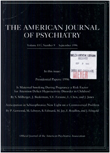Gender and age at onset in schizophrenia: impact of family history
Abstract
OBJECTIVE: The 1-year prevalence of schizophrenia was studied in a limited geographical area of Reunion Island (Indian Ocean) to assess the impact of family history of schizophrenia on the well-known association between gender and age at onset. METHOD: The population of schizophrenic patients meeting the DSM-III-R criteria for schizophrenia (N = 663) was identified and divided according to the presence of another schizophrenic patient among the first- and second-degree relatives. RESULTS: As previously reported, the median age at onset differed between the sexes: the males had an earlier onset (mean age = 27.8 years) than the females (31.5 years). Comparison of the ages at onset according to family history revealed that onset was later for female subjects with a negative family history than for the three other groups (i.e., males with or without a family history and females with a family history). No difference emerged in the comparison of the ages at onset of the males and females with a positive family history. CONCLUSIONS: Comparison of schizophrenic patients with familial versus sporadic disorder confirms the absence of a gender effect for age at onset in the subgroup with familial disorder. This approach also demonstrates the existence of a subgroup composed of affected females having late onset and no family history of schizophrenia.
Access content
To read the fulltext, please use one of the options below to sign in or purchase access.- Personal login
- Institutional Login
- Sign in via OpenAthens
- Register for access
-
Please login/register if you wish to pair your device and check access availability.
Not a subscriber?
PsychiatryOnline subscription options offer access to the DSM-5 library, books, journals, CME, and patient resources. This all-in-one virtual library provides psychiatrists and mental health professionals with key resources for diagnosis, treatment, research, and professional development.
Need more help? PsychiatryOnline Customer Service may be reached by emailing [email protected] or by calling 800-368-5777 (in the U.S.) or 703-907-7322 (outside the U.S.).



